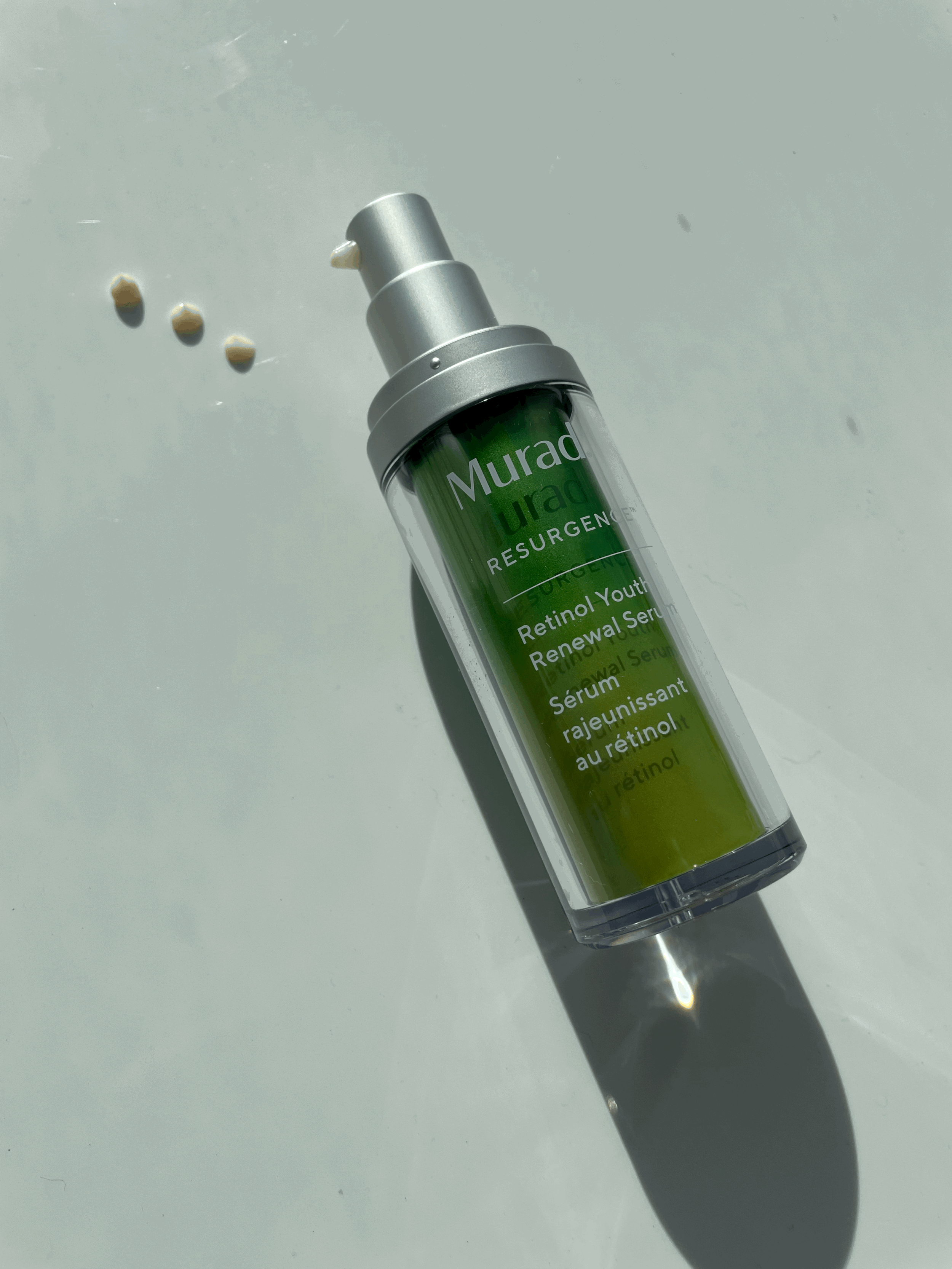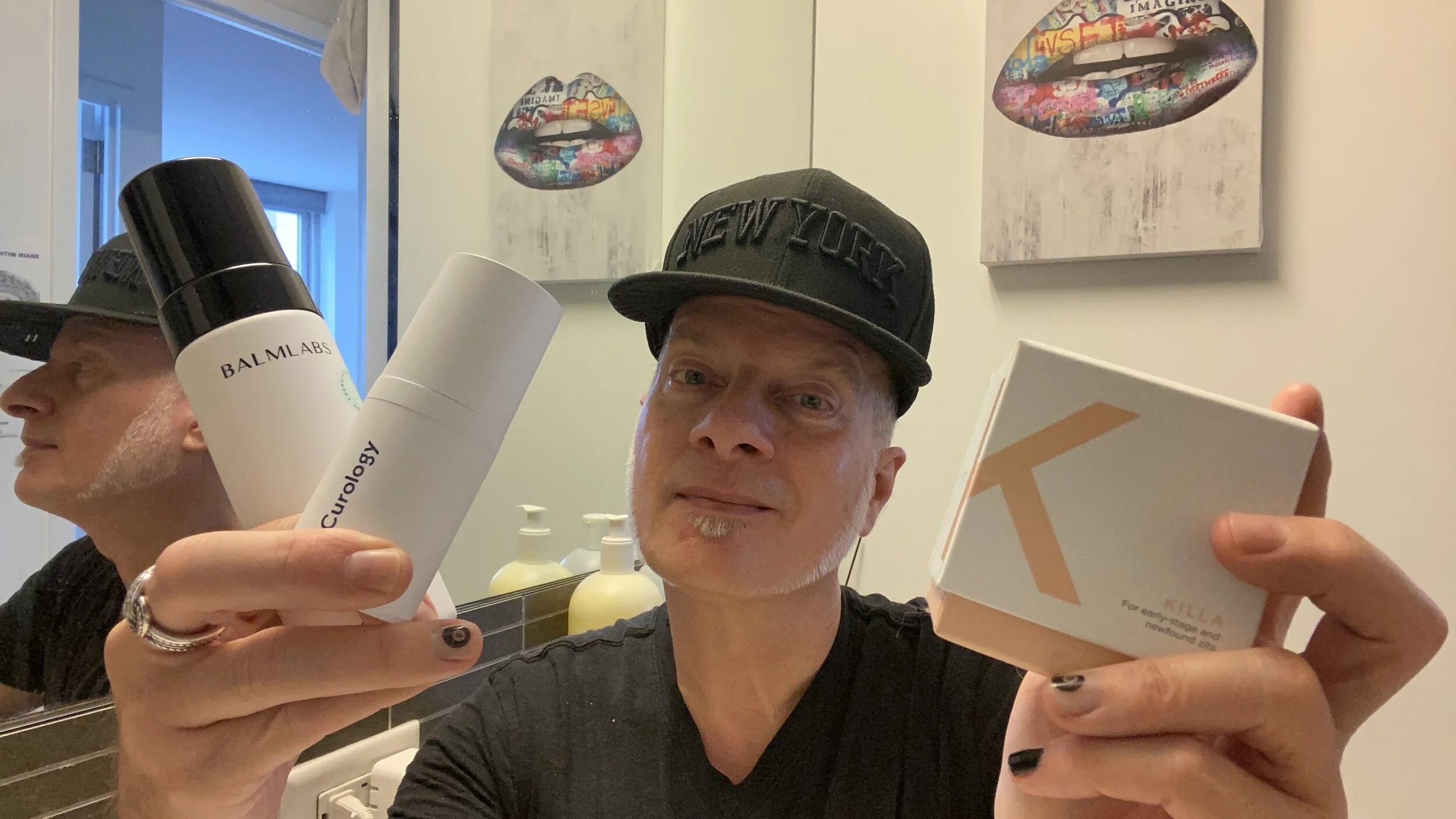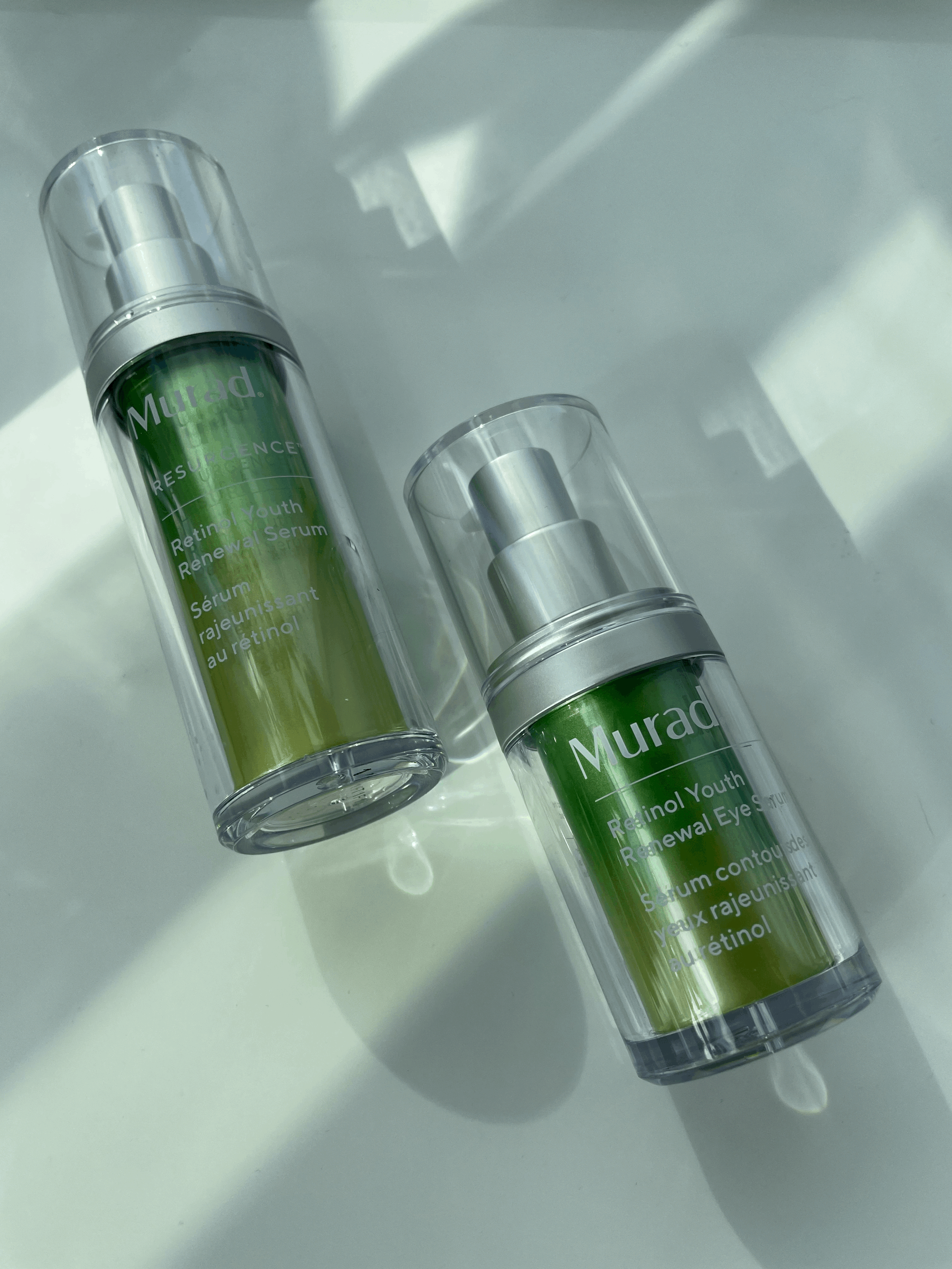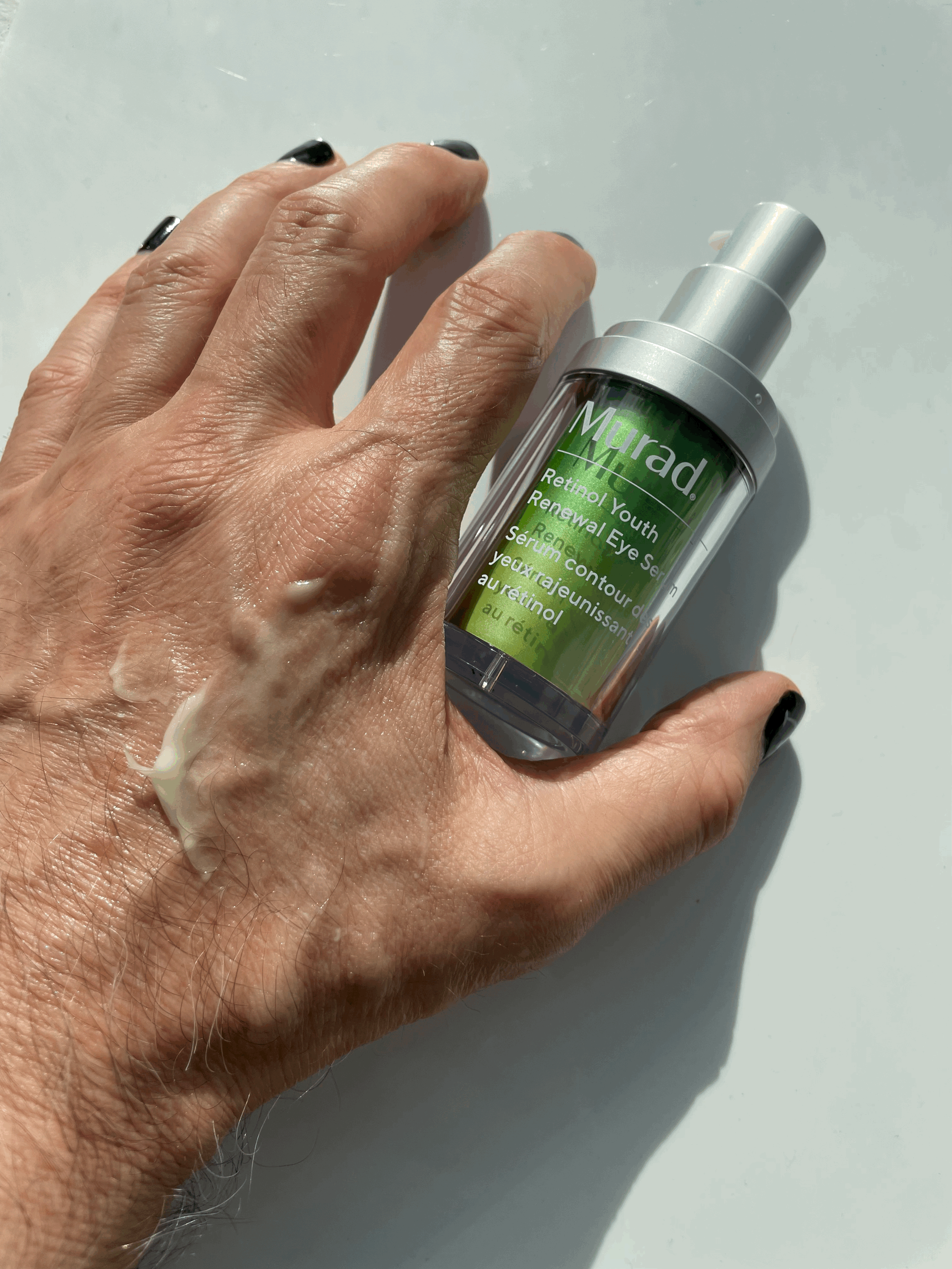PRODUCT REVIEW: MURAD RETINOL YOUTH RENEWAL SERUM - BEST RETINOL SERUM, BEST RETINOL CREAM FOR OILY SKIN
MURAD | RETINOL YOUTH RENEWAL SERUM
A few weeks back, I pulled off what I had long planned — a series of blog articles about all-things-Retinol. I published two consecutive blog articles about the superstar Vitamin A derivative that powers some of the best anti-aging serums, best anti-aging creams and best anti-aging eye creams available today.
The first piece in the series was titled, Retinol, Retinoids, Retinoic Acid Part One: Best Retinol Serums, Best Retinol Creams From Paula's Choice, Wander Beauty And First Aid Beauty.
In part one, I reviewed what I considered to be the gentler five of my top ten retinoid recommendations. Notably, it included two innovative face creams that combine Retinol with Bakuchiol — among them the Paula’s Choice 0.3% Retinol + 2% Bakuchiol Treatment, one of the best anti-aging face creams with Retinol that I’ve come across.
Of course, only Paula and her team would have the nerve to create a top shelf anti-aging treatment that combines Retinol an Bakuchiol. And like another personal fave, Wander Beauty’s Do Not Disturb Overnight Repair Concentrate, it’s a pleasure to use!
PRODUCT REVIEW: PAULA’S CHOICE 0.3% RETINOL + 2% BAKUCHIOL TREATMENT - BEST RETINOL FACE CREAM, BEST BAKUCHIOL
The second of my two-part series followed a week later. Titled, Retinol, Retinoids, Retinoic Acid Part Two: Best Retinol Serums, Best Retinol Creams from Drunk Elephant, Shani Darden, The Ordinary and More!, it rounded out the ten retinoids I’d grown to appreciate over the past 18 months or so.
Murad Retinol Youth Renewal Serum
I must admit that I’m intrigued by the fresh, new, edgier products Murad Skincare has introduced in the last two years. Among the most intriguing to me are the brand’s bestselling Rapid Dark Spot Correcting Serum and Murad’s extensive range of serious acne treatments. Most interesting is the Murad Clarifying Water Gel, an oil-free face cream powered by antiseptic with hazel and acne’s nemesis, Salicylic Acid.
The brand’s acne collection seems legitimate to me and since I’m always looking for acne innovations, I need to check them out.
Murad’s latest innovations include two Retinol treatments — the Murad Retinol Youth Renewal Serum and Retinol Youth Renewal Eye Serum. Both are bestsellers for the brand.
The Murad Retinol Youth Renewal Serum seems like an effective Retinol formula and I’ve actually enjoyed using it — which is not something I often say about Retinol products. Too strong and my skin goes nuts. Too weak and I question whether it’s even worth it.
In fact, I’m actually never sure if Retinol is doing anything for me but that’s only because I’m #blessed with great skin to begin with.
What Is Retinol and What Does Retinol Do for the Skin?
It’s commonly accepted that Retinol and retinoids, more specifically, are the gold standard in anti-aging. Like Vitamin C and Niacinamide (Vitamin B3), the Vitamin A derivative has multiple pro-skin health, anti-aging benefits. Among them are the smoothing of lines and wrinkles, potent antioxidant defense and visible skin firming. As with Niacinamide, topical retinoids — as all derivatives of Vitamin A are referred to — can even minimize the appearance of pores and defend skin against aging environmental damage.
There’s a superb piece on retinoids by the experts on the Paula’s Choice Research Team titled, The Complete Guide To Retinol: The Anti-Aging (And Anti-Acne) Hero — which you can catch here. Here is what I found most salient:
Retinol is classified as a Cell-Communicating Ingredient, which means that it can tell a skin cell how to behave. Retinol ‘tells’ developing skin cell in the lower layers of the skin – called the dermis, to develop normally, instead of a sun-damaged or genetically malformed skin cell. This is how, over time, Retinol can address multiple skin concerns.
Another way Retinol works is also by telling the older cells in the upper layer of skin to die quicker which in turn allows the newer, healthier skin to surface faster. This quicker skin cell turnover rate, paired with cell communicating abilities is what makes Retinol such a superstar!
There are many derivatives and strengths of retinoids available in both over-the-counter (OTC) and prescription products today. The term “Retinol” is the name of the purest form of Vitamin A, and used most often to refer to the non-prescription version of Retinoids.
However, Retinol itself is not active. It has to go through a conversion process in the skin to get to the active form which is then usable by the skin.
Retinyl Palmitate –> Retinol — > Retinaldehyde –> All-Trans-Retinoic Acid (Tretinoin)
There are many forms of retinoids used in skincare today and it can get confusing. Brands and their formulators have multiple format options in seemingly infinite concentrations, depending on the formulation and the product’s claims positioning. Here is a breakdown of the most common forms with a brief description.
Retinyl Palmitate
This form of Vitamin A is created by combining Retinol, or pure Vitamin A, and palmitic acid – a saturated fatty acid derived from palm oil. Retinyl Palmitate is actually naturally occurring in the skin. Because of the lengthy conversion process required within the skin, it’s the least effective of the retinoids. As the weakest form, it’s also generally the most well tolerated.
Retinyl Palmitate gets a bad rap and is on the clean beauty ingredient hit lists of both Sephora and Credo, meaning a formula that contains it cannot be classified as “clean”. According to the experts on the Paula’s Choice Research Team, the claims that it’s unsafe are “based on a study from nearly 20 years ago that has never been reproduced or tested under real-life conditions such as how people use sunscreens that contain this ingredient.”
Retinol
The term “retinol” has become the catch-all for all forms of retinoids in skincare marketing. To be exact, Retinol is the name for the entire vitamin A molecule and the purest form of the antioxidant vitamin. While its anti-aging benefits are proven, it also has legitimate downsides; notably, Retinol can cause extreme sensitization, irritation, redness, dryness and unsightly flaking of the skin.
What causes Retinol irritation? Well, in order to achieve the unparalleled results of Retinol, the molecule must go through a lengthy molecular transformation in the skin as it converts to retinoic acid. It is this conversion process that causes the significant downsides associated with Retinol.
Ironically, while it’s known for causing skin sensitivity, Retinol is also quite sensitive itself. It needs to be packaged in an opaque, air-tight pump as it easily degrades in the presence of light and air. Just like its BFF Vitamin C!
Retinaldehyde (Retinal)
Retinal is even more potent and effective on the retinoid scale than Retinol itself. Interestingly, “Retinaldehyde has promise in being an anti-acne treatment, without the same harsh side effects of its prescription cousins.”
Because it is perhaps the most expensive of the retinoid class, it’s seldom used in topical skincare products — and is reserved for the savvy marketers who want their Retinol treatment to sound unique and to boast the highest efficacy without a prescription. The default is most often to formulate with the less expensive Retinol. Because of its higher potency, Retinaldehyde is used in lower concentrations, which can give the impression that the formula is weaker from a marketing perspective.
Retinyl Retinoate
This synthetic form of Vitamin A is part of a new generation of retinoids. Because of its slower conversion in the skin into Retinoic Acid, studies have shown it to be less problematic for skin than Retinol and pure form of topical Retinoic Acid — more commonly known as Tretinoin or Retin-A.
Because of the serious downsides of using Retinol, Retinyl Retinoate may become increasingly popular in the years ahead.
Best Retinol Face Creams and Serums
Hydroxypinacolone Retinoate (HPR) or Granactive Retinoid
Marketed as Granactive Retinoid, Hydroxypinacolone Retinoate (HPR) is the newest and most promising member of the class of anti-aging retinoids. HPR is an ester of retinoic acid with benefits on par with prescription-strength retinoic acid, commonly known as Tretinoin or Retin-A. The greatest benefit is that HPR is more readily tolerated by the skin, with none of the side effects of Retinol or retinoic acid — including irritation, sensitivity, dryness and flakiness.
How is it possible to have the upside without the downside? In order for the skin to benefit from Retinol, the Vitamin A molecule goes through a transformation process as it converts to retinoic acid in the skin. It is this conversion that leads to the irritation common to Retinol. Hydroxypinacolone retinoate does not require a lengthy conversion in order to achieve the sought-after anti-aging benefits of Retinol, making it far more tolerable.
Tretinoin / Retin-A
With Retinyl Palmitate at the low end of the retinoid scale, Tretinoin (or Retin-A) is at the exact opposite end — the strongest of the retinoids known as retinoic acid, the generic name for synthetic Vitamin A. Tretinoin is only available by prescription in most countries — except notably, Mexico, where its access is quite pervasive. Even I have been caught up in grabbing tubes of Retin-A at the airport before my flights home.
While Tretinoin is commonly used to treat signs of aging including fine lines, wrinkles and dark spots, the versatile medication is also an effective treatment for acne and sun-damaged skin. According to the Healthline website, “It may sound counterintuitive, but tretinoin works by irritating the skin. Tretinoin is able to speed up the life cycle of skin cells. It makes them divide faster and die faster, so newer, healthier cells can take their place.”
Notably, Murad’s Retinol Youth Renewal Serum formula is not “clean” — which is perfectly okay with me, though I prefer it. Regrettably, the Retinol Youth Renewal Serum contains fragrance and colorants. I have no idea why the brand would put fragrance into a potentially sensitizing treatment like a Retinol serum. That just seems like complete nonsense to me.
The inclusion of colorants and fragrance don’t negate the pro-skin health goodness of the Retinol Youth Renewal Serum, including anti-aging Retinol, replenishing lipids and antioxidant botanical oils and extracts.
Murad’s Retinol Youth Renewal Eye Serum is my fave of the two new Retinol products. I love a gentle Retinol eye cream and this baby is light, hydrating and refreshing — perfect for daytime use along with sunscreen, of course.
That sounds crazy to say, right? We’re all conditioned to believe that you shouldn’t use Retinol during the daylight hours and particularly when out in the sun. That’s a total myth. As long as your skin is tolerating the Retinol well and you’re not experiencing any sensitivity, irritation or redness, you can use Retinol during the day. Just be sure you’re wearing a sunscreen!
I’ve seen zero irritation with the Retinol Youth Renewal Eye Serum and it’s simply a pleasure to use. Like the brand’s Retinol Youth Renewal Serum, the Murad Retinol Youth Renewal Eye Serum is packed with pro-skin health goodness. Again, it contains fragrance and colorants, which I’d prefer it didn’t.
If you’re looking for something light and refreshing for day, the Retinol Youth Renewal Eye Serum might intrigue you, too.
SHOP THE BLOG: Purchase the Murad Retinol Youth Renewal Serum for $89 here. Purchase the Murad Retinol Youth Renewal Eye Serum for $85 here.
The Ingredient List of the Shani Darden Skin Care
Texture Reform:
 so|h, Lactic Acid
so|h, Lactic Acid  exf|h|buff, Retinyl Palmitate cci 1-3 1-3, Hydroxyethyl Acrylate/Sodium Acryloyldimethyl Taurate Copolymer vc, Isohexadecane emo|solv, Polysorbate 60 emu|surf, Potassium Hydroxide buff, Propylene Glycol h|solv|vc 0 0, Glycereth 26 h|emo|vc 0 0, Polyacrylate Crosspolymer-6 vc, Phenethyl Alcohol, Caprylyl Glycol h|emo, Ethylhexyl Glycerin pres, Sodium Pca
exf|h|buff, Retinyl Palmitate cci 1-3 1-3, Hydroxyethyl Acrylate/Sodium Acryloyldimethyl Taurate Copolymer vc, Isohexadecane emo|solv, Polysorbate 60 emu|surf, Potassium Hydroxide buff, Propylene Glycol h|solv|vc 0 0, Glycereth 26 h|emo|vc 0 0, Polyacrylate Crosspolymer-6 vc, Phenethyl Alcohol, Caprylyl Glycol h|emo, Ethylhexyl Glycerin pres, Sodium Pca  sii|h 0 0, Coffea Arabica (Coffee) Fruit Extract aox, Beta-Glucan
sii|h 0 0, Coffea Arabica (Coffee) Fruit Extract aox, Beta-Glucan  so|h, Hydrolyzed Soybean Palmitate, Acetyl Glucosamine
so|h, Hydrolyzed Soybean Palmitate, Acetyl Glucosamine  sii|sb, Niacinamide
sii|sb, Niacinamide  cci|sb|aacne|h
cci|sb|aacne|hThe Ingredient List of the Shani Darden Skin Care Retinol Reform:
 sii|h 0 0, Pyrus Malus (Apple) Fruit Extract
sii|h 0 0, Pyrus Malus (Apple) Fruit Extract  h, Lactic Acid
h, Lactic Acid  exf|h|buff, Hydroxyethyl Acrylate/Sodium Acryloyldimethyl Taurate Copolymer vc, Lactobacillus Ferment
exf|h|buff, Hydroxyethyl Acrylate/Sodium Acryloyldimethyl Taurate Copolymer vc, Lactobacillus Ferment  so|pres, Isohexadecane emo|solv, Retinol
so|pres, Isohexadecane emo|solv, Retinol  cci, Copernicia Cerifera Cera (Copernicia Cerifera (Carnauba) Wax, Cire De Carnauba) emo 0 1, Glucosamine Hcl, Plankton Extract, Camellia Sinensis Leaf Extract
cci, Copernicia Cerifera Cera (Copernicia Cerifera (Carnauba) Wax, Cire De Carnauba) emo 0 1, Glucosamine Hcl, Plankton Extract, Camellia Sinensis Leaf Extract  aox|so, Aloe Barbadensis Leaf Juice
aox|so, Aloe Barbadensis Leaf Juice  so|h, Tocopheryl Acetate aox 0 0, Niacinamide
so|h, Tocopheryl Acetate aox 0 0, Niacinamide  cci|sb|aacne|h, Hydrogenated Lecithin
cci|sb|aacne|h, Hydrogenated Lecithin  emo|emu, Linoleic Acid
emo|emu, Linoleic Acid  sii|emo|surf, Glycine Soja (Soybean) Sterols emo, Phospholipids
sii|emo|surf, Glycine Soja (Soybean) Sterols emo, Phospholipids  sii|emo, Propanediol solv|h, Sodium Cocoamphoacetate surf, Sorbitan Isostearate emu 0 1-2, Polysorbate 60 emu|surf, Oryza Sativa (Rice) Bran Extract, Rosmarinus Officinalis (Rosemary) Leaf Extract
sii|emo, Propanediol solv|h, Sodium Cocoamphoacetate surf, Sorbitan Isostearate emu 0 1-2, Polysorbate 60 emu|surf, Oryza Sativa (Rice) Bran Extract, Rosmarinus Officinalis (Rosemary) Leaf Extract  aox|so|amic, Helianthus Annuus (Sunflower) Extract
aox|so|amic, Helianthus Annuus (Sunflower) Extract  so|emo, Tocopherol
so|emo, Tocopherol  aox 0-3 0-3, Cyamopsis Tetragonoloba,(Guar) Gum vc, Maltodextrin, Xanthan Gum vc, Lecithin
aox 0-3 0-3, Cyamopsis Tetragonoloba,(Guar) Gum vc, Maltodextrin, Xanthan Gum vc, Lecithin  emo|emu, Hydrolyzed Algin, Xylitylglucoside
emo|emu, Hydrolyzed Algin, Xylitylglucoside  h, Anhydroxylitol
h, Anhydroxylitol  h, Xylitol
h, Xylitol  h, Tetrasodium Glutamate Diacetate chel, BHT aox|pres, BHA
h, Tetrasodium Glutamate Diacetate chel, BHT aox|pres, BHA  aox|pres, Sodium Hydroxide buff, Phenoxyethanol pres, Caprylyl Glycol h|emo, Ethylhexylglycerin pres, Hexylene Glycol solv|emu|perf|surf 0-1 0-2
aox|pres, Sodium Hydroxide buff, Phenoxyethanol pres, Caprylyl Glycol h|emo, Ethylhexylglycerin pres, Hexylene Glycol solv|emu|perf|surf 0-1 0-2The Ingredient List of the Shani Darden Skin Care
Sake Toning Essence:
 so|h, Glycerin
so|h, Glycerin  sii|h 0 0, Rosa Canina Fruit Extract, Butylene Glycol h|solv|vc 0 1, Niacinamide
sii|h 0 0, Rosa Canina Fruit Extract, Butylene Glycol h|solv|vc 0 1, Niacinamide  cci|sb|aacne|h, Phenoxyethanol pres, Isoceteth-20 emu|surf, Xanthan Gum vc, Aminopropyl Ascorbyl Phosphate
cci|sb|aacne|h, Phenoxyethanol pres, Isoceteth-20 emu|surf, Xanthan Gum vc, Aminopropyl Ascorbyl Phosphate  aox|sb, Tetrasodium Glutamate Diacetate chel, Tocopheryl Acetate (Vitamin E) aox 0 0, Natural Fragrance
aox|sb, Tetrasodium Glutamate Diacetate chel, Tocopheryl Acetate (Vitamin E) aox 0 0, Natural Fragrance  perf, Camellia Sinensis (Green Tea) Japanese, Ethylhexylglycerin pres, Citric Acid buff
perf, Camellia Sinensis (Green Tea) Japanese, Ethylhexylglycerin pres, Citric Acid buff



















